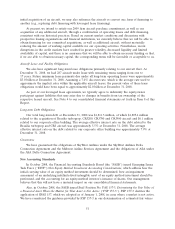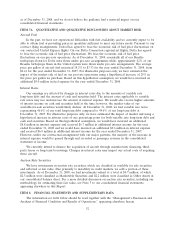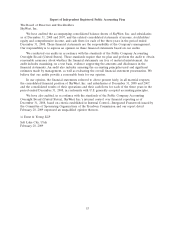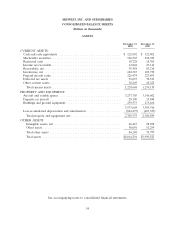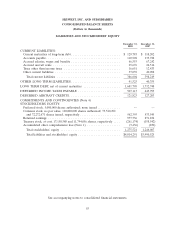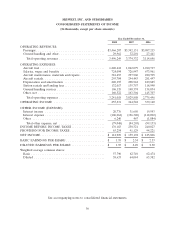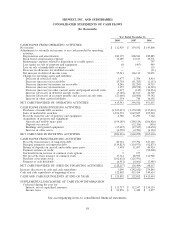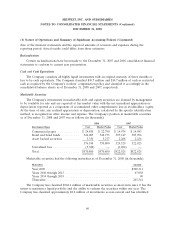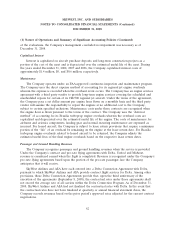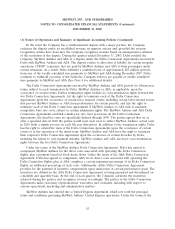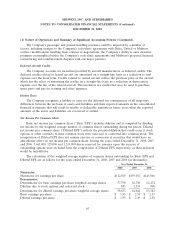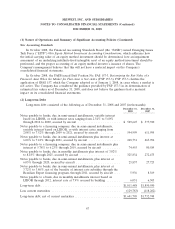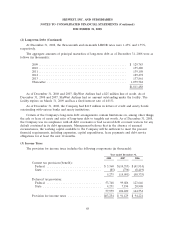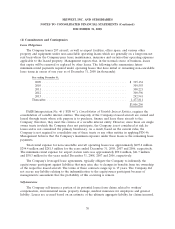SkyWest Airlines 2008 Annual Report Download - page 65
Download and view the complete annual report
Please find page 65 of the 2008 SkyWest Airlines annual report below. You can navigate through the pages in the report by either clicking on the pages listed below, or by using the keyword search tool below to find specific information within the annual report.
SKYWEST, INC. AND SUBSIDIARIES
NOTES TO CONSOLIDATED FINANCIAL STATEMENTS (Continued)
DECEMBER 31, 2008
(1) Nature of Operations and Summary of Significant Accounting Policies (Continued)
them as ‘‘Other assets’’ in the Company’s consolidated balance sheet as of December 31, 2008 (see
Note 5).
Inventories
Inventories include expendable parts, fuel and supplies and are valued at cost (FIFO basis) less an
allowance for obsolescence based on historical results and management’s expectations of future
operations. Expendable inventory parts are charged to expense as used. An obsolescence allowance for
flight equipment expendable parts is accrued based on estimated lives of the corresponding fleet types
and salvage values. The inventory allowance as of December 31, 2008 and 2007 was $5.5 million and
$4.7 million, respectively. These allowances are based on management estimates, which are subject to
change.
Property and Equipment
Property and equipment are stated at cost and depreciated over their useful lives to their
estimated residual values using the straight-line method as follows:
Depreciable Residual
Assets Life Value
Aircraft and rotable spares ...................... 10 - 18 years 0 - 30%
Ground equipment ............................ 5 - 7 years 0%
Office equipment ............................. 5 - 7 years 0%
Leasehold improvements ........................ 15 years 0%
or life of
the lease
Buildings ................................... 20 - 39.5 years 0%
Impairment of Long Lived and Intangible Assets
As of December 31, 2008, the Company had approximately $2.7 billion of property and equipment
and related assets. Additionally, as of December 31, 2008, the Company had approximately
$26.2 million in intangible assets. In accounting for these long-lived and intangible assets, the Company
makes estimates about the expected useful lives of the assets, the expected residual values of certain of
these assets, and the potential for impairment based on the fair value of the assets and the cash flows
they generate. On September 7, 2005, the Company completed the acquisition of all of the issued and
outstanding capital stock of ASA. The Company recorded an intangible asset of approximately
$33.7 million relating to the acquisition of ASA. The intangible is being amortized over fifteen years
under the straight-line method. As of December 31, 2008 and 2007, the Company had $7.5 million and
$5.2 million in accumulated amortization expense, respectively. Factors indicating potential impairment
include, but are not limited to, significant decreases in the market value of the long-lived assets, a
significant change in the condition of the long-lived assets and operating cash flow losses associated
with the use of the long-lived assets. On a periodic basis, the Company evaluates whether the book
value of its aircraft is impaired in accordance with Statement of Financial Accounting Standards
(‘‘SFAS’’) No. 144, Accounting for the Impairment or Disposal of Long-Lived Assets. Based on the results
61


